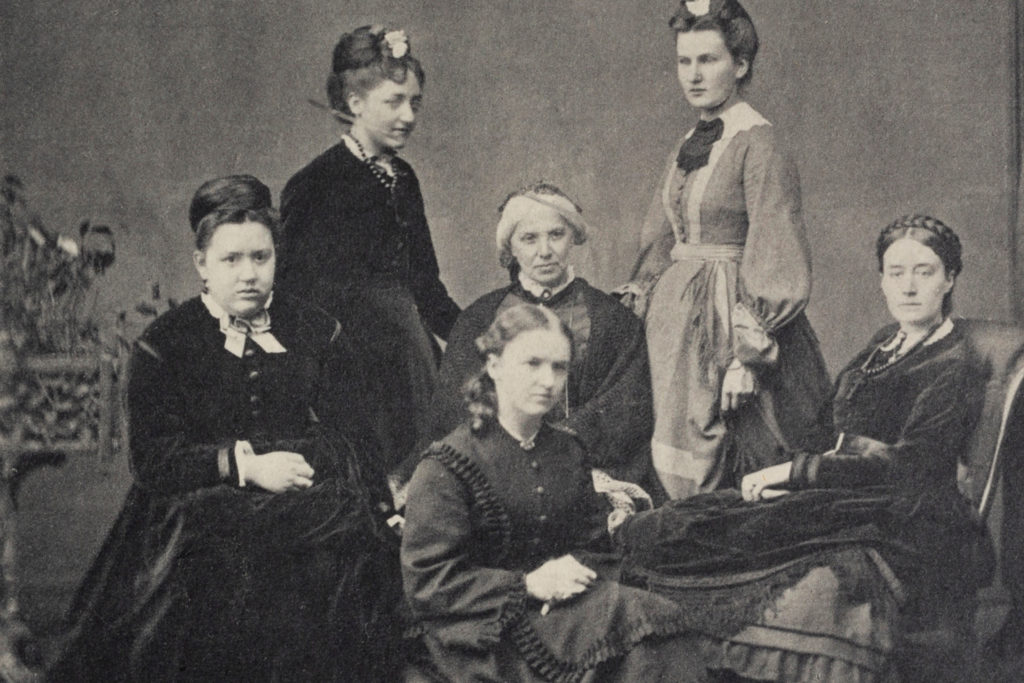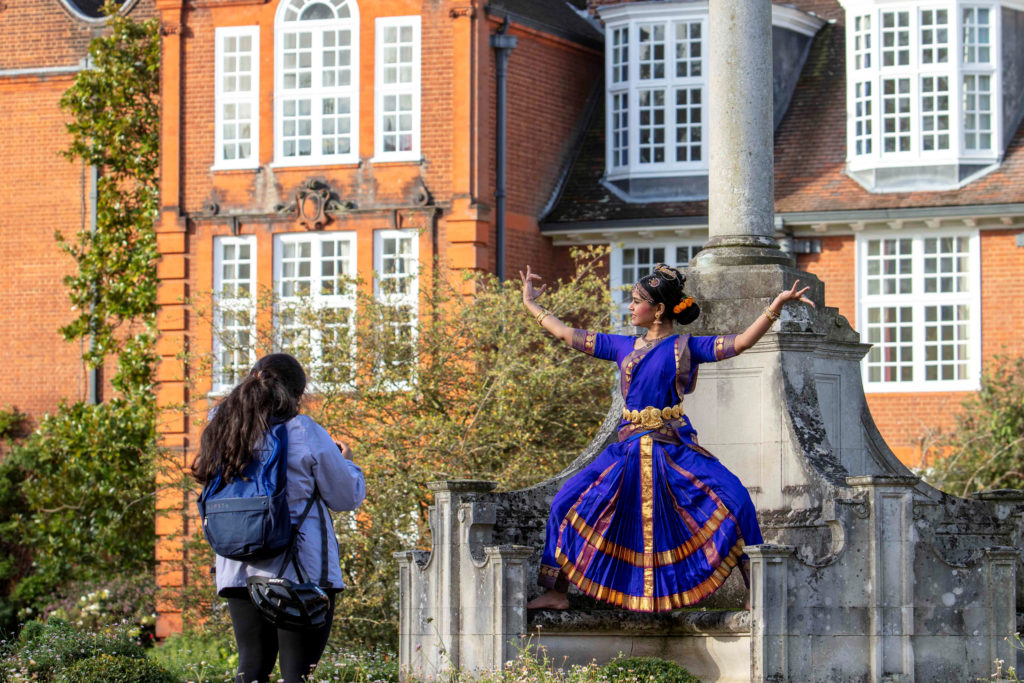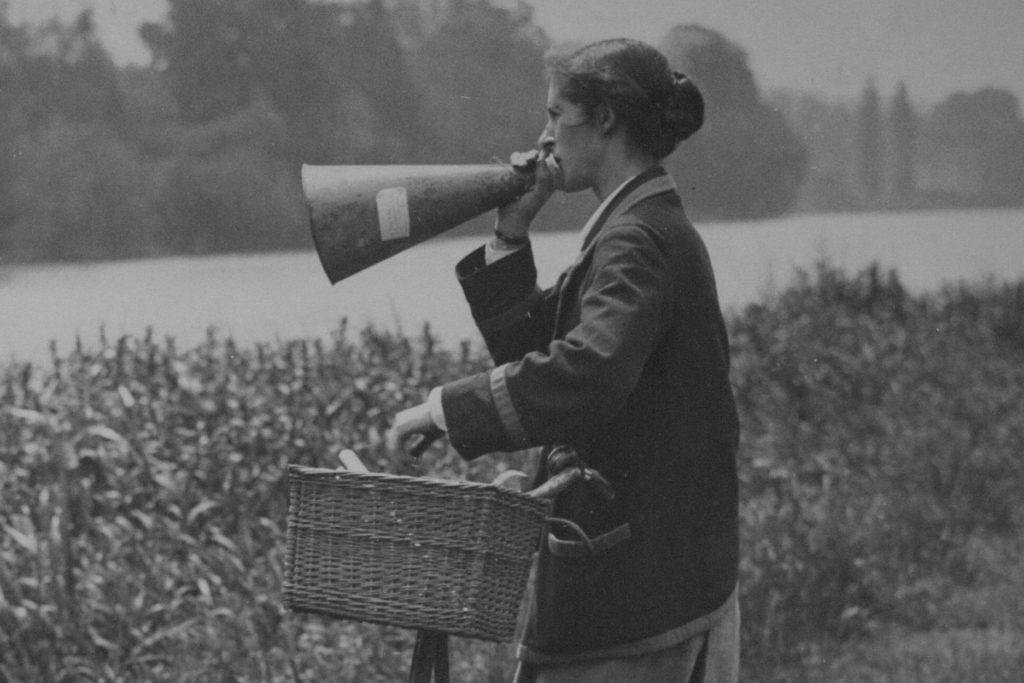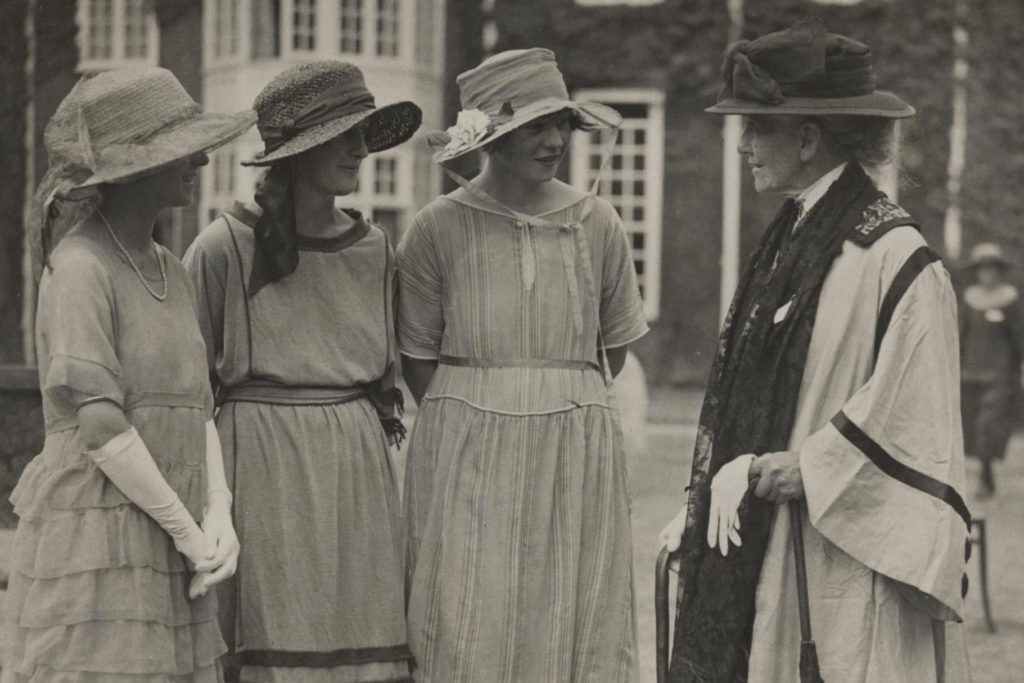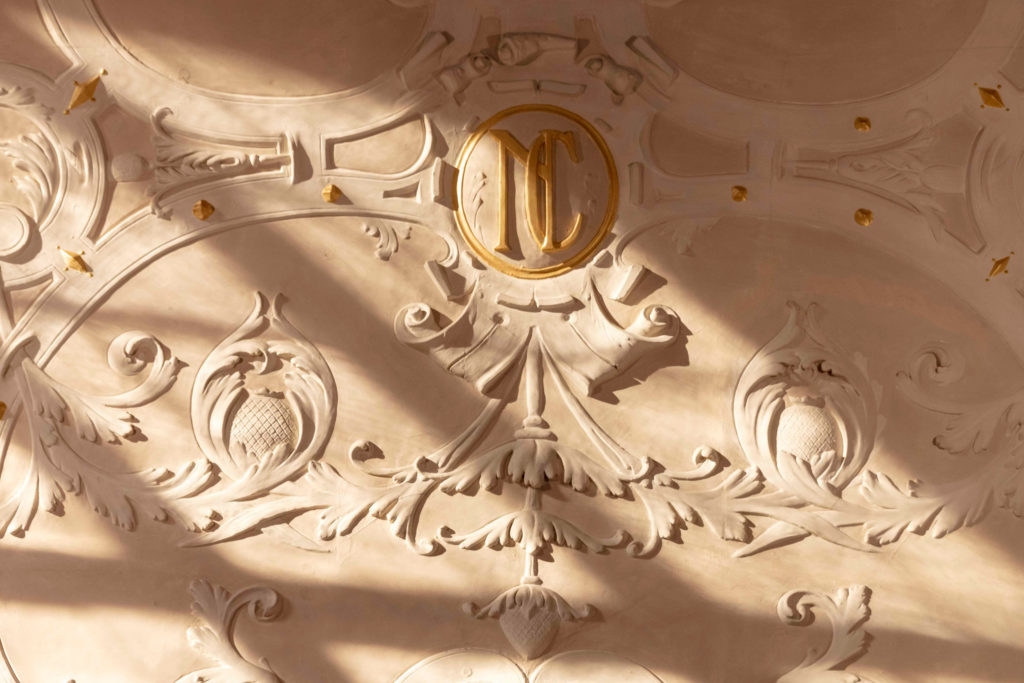Home / Newnham Virtual Festival / 150 Years of Library & Archive Collections
In this exhibition we explore 150 years of Newnham Library & Archive collections. Decade by decade, we suggest ways in which our collections have developed to reflect the College’s history and its growth as a centre of education, learning and research
From founding documents of the 1870s held in the College Archives, the growth of student societies in the 1880s, the move to a new Library building in the 1890s, via various donations of books by supporters and alumnae, we move from the earliest decades of college collections into the twentieth and twenty first centuries. Original working library material becomes historically significant in later years; records from the College Archives shed light on the College’s early outreach activities; rare books and special collections continue to grow through donations, and are celebrated through displays and exhibitions. In more recent decades, new accommodation for special collections is provided, while library staff catalogue the collections in more depth and conservators assist with advice and expertise in the preservation of materials. The future brings prospects for new research and new discoveries and for sharing materials through digitisation projects. We hope you enjoy our exhibition!









1870s: EARLY HISTORY
Reports on the development and activities of the College, 1874–1880; flyer and ticket for the Lectures for Women, 1871; photographs of Merton Hall and Old Hall, 1870s.
In the autumn of 1871, five students took up residence in the house at 74 Regent Street, which Henry Sidgwick had established to enable them to attend his lectures for women in Cambridge. By October 1875, Newnham Hall (Old Hall) had been built and 27 students were living there. By the end of the decade, the Lectures Association and the Newnham Hall Company had amalgamated to form the Newnham College Association for Advancing Learning and Education Among Women in Cambridge, and the College became a single legal entity. The records in the College Archives document the College’s origins and development over this critical decade, as well as giving an impression of what it was like to study at Newnham at that time.
READ MORE
0/0
1880s: STUDENT LIFE - CLUBS AND SOCIETIES
Programme of Newnham College Musical Society’s first concert
1886 saw the first concert of the Newnham College Musical Society, which continues today as the Raleigh Music Society. In March 1886 they played Schubert, Chopin and Mendelssohn.
There were several other clubs and societies established in the 1880s, including the Political Society, which took the form of a parliament, and whose early members included Susan Lawrence (later to become one of the first women Labour MPs) and Susila Bonnerjee (doctor, suffrage campaigner and educator); the Old Hall Fire Brigade, drilled to defend the building in the event of fire; and the Gradus ad Parnassum debating society. This extract from the 1885 Newnham College Club Cambridge Letter (precursor to the Roll Letter) records the activities of a late-night literary society for students with a sweet tooth, and their eventual resolve to support a growing fiction collection:
The Poetry Society held its meetings all last year at 10 P.M. on Saturdays, at which members were allowed to do their necessary mendings. Five minutes’ grace is allowed and then 1d. is charged for every five minutes up to 20 minutes past ten when late comers are put on a footing with absentees and fined 3d. The fines last year went towards a Chocolate feast at the end of term, but now it has been decided that this was unworthy of the dignity of the Society and the money is to go towards the purchase of books for the Novel Library.
READ MORE
0/0
1890s: Expansion of the Library
Library ceiling detail of the printer’s mark of the Parisian Estienne family
After dedicating its early years to collecting the books necessary for Tripos courses and a working library, by the 1890s Newnham was beginning, by way of donations of books, to build its rare book collections. The College report of 1896 states that ‘though the chief object of the Library is to provide such books as are needed for the different branches of study, it also contains a few old and rare works which add greatly to its general interest’. The earliest accession register records these gifts, including an Italian-English-French dictionary (1789) and The Guide into Tongues (1617) presented in 1898 and 1899 respectively by the former University of Cambridge Librarian, Professor Mayor. In 1896, the philologist and co-creator of the New English Dictionary F. J. Furnivall donated Holinshed’s Chronicles of England, Ireland, and Scotland (1587). Bibliophile and noted collector Henry Yates Thompson was a generous benefactor to Newnham’s special collections, and his donations in this period included a 1617 edition of Spenser’s Faerie Queene and an English translation of Don Quixote (1675). Yates Thompson also funded the building of a new Library in 1897, featuring a ceiling adorned with the emblems of his favourite printers and locked glazed cupboards for the secure storage of early printed books.
READ MORE
0/0
1900s: Works by Newnham authors
Monograph of British Graptolites / Gertrude Elles and Ethel Wood
By the 1900s, Newnham alumnae were donating their own published works to the Library. The Library’s early records show gifts from Gertrude Elles (NC 1891) and Ethel Wood (NC 1891), who studied Natural Sciences together at Newnham (Gertrude Elles went on to become one of the first female fellows of the Geological Society of London, and Cambridge University lecturer in Geology). They donated new volumes of their Monograph of British Graptolites (pictured above) each year as they were published. Hertha Beatrice Coryn Sollas (NC 1897) donated her translation of Suess’s Face of the Earth. Mary Augusta Scott (NC 1886), who gave the Library her edited volume of Bacon’s Essays, became one of the first women to receive a PhD from Yale University and later its first woman Fellow. Florence Melian Stawell (NC 1889), who studied Classics and later lectured in the same subject, presented her monograph, Homer and the Iliad, while Newnham classicist and linguist Jane Harrison (NC 1874) donated two of her works: Religion in Ancient Greece and Prolegomena to the Study of Greek Religion. These early donations formed the beginnings of our present-day ‘Newnham collection’ of works by and about Newnham alumnae.
READ MORE
0/0
1910s: The Campaign for Women's Suffrage and the First World War
Women’s Suffrage / Millicent Garrett Fawcett (1912); The Women’s Victory and After: Personal Reminiscences 1911–1918 / Millicent Garrett Fawcett (1920); Public General Acts (1917–18)
The Representation of the People Act 1918 enfranchised a limited number of women: those over the age of 30 who were a member of, or married to, a member of the Local Government Register, or a graduate voting in a University constituency. In 1928, the Equal Franchise Act was passed, giving women equal voting rights to men.
Newnham College founder Millicent Garrett Fawcett was president of the National Union of Women’s Suffrage Societies (NUWSS). In 1903, the Pankhurst sisters set up the Women’s Social and Political Union (WSPU), which aspired to ‘Deeds not words’ and took direct action through disruption, vandalism and arson. Millicent Garrett Fawcett firmly disagreed with their violent campaign methods but visited the WSPU members incarcerated in Holloway prison and held a banquet in their honour once they had been released.
Following the outbreak of war in 1914, Millicent Garrett Fawcett chose to suspend the suffrage campaign to support an organised war effort. According to Ray Strachey, ‘It only very gradually dawned upon us that one of the first results of the war would be the emancipation of women in our own and many other countries’ (Our Freedom and Its Results, by Five Women. Hogarth Press, 1936. p.87).
The Newnham College 150th Treasures page has more information about the Suffrage banner created by Newnham and Girton students and about the Women’s War Work Record of 1922, a document which was digitised in 2018 and which can now be viewed online.
READ MORE
0/0
1920s: Working women's summer schools
The first Summer School for working women at Newnham College, 29 July–12 August 1922 (photographer C. W. Vorley, Raunds)
The idea of holding a summer course for working women at Newnham during the long vacation emerged from a motion put forward at the 1921 Annual Meeting of the Newnham College Roll by former students with an active interest in adult working women’s education. It proposed that ‘the effort to provide College education for working women should receive all possible support’ (Newnham College Roll Letter 1923, p.38-42). A committee was duly convened, and the first Summer School was planned for 1922.
The 27 women who attended came from across the country, their ages ranged from 18 to 61 and four were married. Their occupations included: Forewomen in Cocoa Works (Rowntrees), Clerks in Works, Government Clerks, Poor Law Assistant, Married and at home, Tobacco Packer, Tailoresses and Machinists, Bookshop Assistant, Shop Assistants, Bookbinder and Photographer.
The women spent up to a fortnight living in College alongside students who were resident for the long vacation. They attended lectures and discussions on English, History and Economics, received private coaching and were joined by the regular students at special evening lectures. They also participated in College social activities, including excursions, river parties and tennis. The initial experiment was deemed a success and the courses continued to run every other year until 1950. An unnamed attendee who wrote an account of her first experience of a Newnham Summer School explained that:
No working woman need be afraid of going to one of these Schools. No matter how little she knows, so long as she possesses the desire to know. The tutors have the tact and kindly spirit to make you think you know more than you do, only you lack the power of self expression. […] For a young woman to attend one of these schools often means the beginning of beginnings. It is the opening of a door to other things. It draws the curtain aside from all the trivial things that surround a working woman’s life.
A Working Woman’s First Experience of a Holiday Course at Newnham Summer School, undated.
READ MORE
0/0
1930s: The Rogers Collection
Crepe paper books of Japanese fairy tales from the Rogers collection
In 1934, Newnham College was given 358 volumes by Dr G. F. Rogers, a Cambridge medic who studied at Caius in the 1880s. His donation of late-nineteenth-century children’s books, folklore and fairy tales forms the core of the ‘Rogers Collection’. His gift also included several books on animal magnetism and mesmerism and two collections of stories by the high priestess of Theosophy, Madame Blavatsky. Other items include a rare pamphlet by Cicely Hamilton, the suffragist and playwright, a first edition of a 1901 novel by Joseph Conrad and Ford Madox Ford (then Hueffer), runs of two rare periodicals, The Green Sheaf and The Dome, along with early editions of W. B. Yeats’ poems.
Over the years, the core Rogers collection has been expanded to include similar books from different donors. We refer to these as the Rogers’ Additions, and there are now almost as many additional titles as there were volumes in the original bequest. Their provenance often reveals further Newnham connections: Katharine Stephen (Librarian, then from 1911 the third Principal) likely contributed a copy of her French History for English Children, published initially under the pseudonym of Sarah Brook. There is a sizeable contribution from the estate of Lady Agatha Russell, Bertrand Russell’s aunt, who died in 1933 and was a major benefactor of the College. From the estate of May Wallas (NC 1917, Fellow 1945-62), there are the collections of European folk and fairy tales accumulated by her mother, Ada Wallas, née Radford (NC 1881), when Ada turned her attention from contemporary fiction to writing for children at the beginning of the twentieth century. There are gifts from Newnham authors such as Catherine Storr and Ann Phillips. Gifts like these are the building blocks for a study of the books not simply owned but kept, cherished – and written – by successive generations of educated women.
With thanks to Dr Gill Sutherland.
READ MORE
0/0
1940s: Pictorial Press photographs of the College in 1941
Fire Brigade Roof Drill, Old Hall, 1941 (Pictorial Press)
When the Pictorial Press photographer visited Newnham in 1941, the College was thriving despite the strictures of the war. The author of the Present Student’s Letter in that year’s Roll Letter observed that Newnham was ‘fuller than ever’, with some of the first years sharing rooms, and Bedford College renting lecture rooms to escape the blitz in London.
She continues, ‘Air raid warnings are few and far between, and that aspect of the war only presents itself now when it is our turn to be “on duty” in the fire-post’. Nonetheless, the student Fire Brigade carried out many ‘roof practices’, and the First Aid Detachment took part in a large-scale mock air raid simulating the destruction of Old Hall’s staircase. Cambridge saw some significant raids targeting the railway early in the year, and more were to come.
As for the practicalities of daily life, rationing was in force and issues with the food supply were ‘most noticeable in the shortage of milk, and also the faint odour which sometimes reminds us that onions are stored in the roof spaces of Clough’. As many of the housekeeping staff had left to take up war work, the students took turns to dust the Library.
READ MORE
0/0
1950s: Celebrating collections - illustrated books on natural history
Gerard’s Herball (1597)
Following the end of the Second World War, Newnham’s rare books were celebrated in a series of exhibitions for members of the College. We have surviving notes from a 1954 exhibition of illustrated books on natural history divided into two parts: the first on Quadrupeds and Birds and the second on Flowers and Insects. Exhibits included Paradisi in Sole (1629), a title that punned on the author’s surname, Parkinson, and Gerard’s Herball (1597), which features 1800 woodcuts, of which, the notes tell us, ‘[the] figure of the potato is probably the first illustration of the plant ever published’. The then novelty vegetable reappears in the ‘very much enlarged and amended’ edition of 1636, in which Gerard is depicted on the engraved title page holding a potato plant. The surviving exhibition caption reads [Gerard’s] ‘botanical knowledge was insufficient to enable him to place the correct illustration with each description, and the publisher had to ask a Flemish botanist to correct his blunders’. The caption also draws attention to the inclusion of the mythical ‘Goose Tree (which he himself claims to have seen)’.
The exhibition was almost certainly curated by Edith Chrystal, who held multiple positions at the College, including Tutor, Junior Bursar, Director of Studies in Theology, Vice-Principal, Praelector, Registrar of the Roll and from 1941 to 1954, Librarian. She clearly had fun curating this exhibition, remarking that John Parkinson’s Theatrum Botanicum (1640) ‘is eloquent on the subject of the unicorn’. On Hogg and Johnson’s The Wild Flowers of Great Britain (1863-78), readers are advised that ‘The lithographed plates are by W.G. Smith, except for most of those in vol. 1, which are by Charlotte Gower and are of a high artistic standard’. On viewing W. B. Tegetmeier’s Pigeons (1868), visitors were invited to ‘Compare the crudeness of the colouring of these plates with those of the other books’.
READ MORE
0/0
1960s: A scholar's bequest
The first sermon preached to King Charles / John Donne (1625)
Evelyn Spearing was among Newnham alumnae who presented their authored works to the College Library in the early 1900s. Born in Cambridge in 1885, she came to Newnham in 1905 to study Modern and Medieval Languages, specialising in English and Romance Philology, and achieving a First in 1908. She was the first woman to be awarded a DPhil at the University of Oxford on 18th November 1922, becoming a noted scholar of Elizabethan and seventeenth-century English literature and an authority on the prose works of John Donne.
After her marriage, she continued to research and publish as Evelyn Simpson, with her landmark ten-volume edition of The Sermons of John Donne appearing between 1953 and 1962. She died in 1963, bequeathing to Newnham several early editions of the works of John Donne, a collection she began as Associates’ Research Fellow at Newnham in 1911.
READ MORE
0/0
1970s: Transition from 'working library' to 'special collections'
Maria Gaetana Agnesi’s Instituzioni analitiche... presented by Philippa Fawcett
Prior to the construction of the rare books room in 1982, a number of Newnham’s early printed books were, or had been, part of the working library. These were stored on the open shelves or at the back of the Library office in a secure bookstack, which by the 1970s was almost full. A thorough survey and listing was carried out, and among those books which were shortly to find a new, environmentally-controlled home were mathematical books, including early editions of Euler, Lagrange and Gauss, as well as this wonderful two-volume 1748 edition of Maria Gaetana Agnesi’s Instituzioni analitiche ad uso della gioventu’ italiana. This work by a pioneering female mathematician was presented to the College by Philippa Fawcett, Newnham’s own pioneering mathematician.
READ MORE
0/0
1980s: A bequest of private press books
Kelmscott Press Beowulf
Newnham’s links with the Arts and Crafts movement are reflected in the Library’s special collections with a number of examples of ‘private press’ books, which celebrate the materials, printing techniques and binding methods associated with the European early printed book tradition. Our collection has some wonderful examples from William Morris’s Kelmscott Press in the 1890s, the Essex House Press, Doves Press, Shakespeare Head Press, Golden Cockerell Press and Rampant Lions Press among others. The example in the illustration above is The Tale of Beowulf, printed by William Morris at the Kelmscott Press in 1895 and one among a collection of private press volumes bequeathed to the College by Dorothy de Navarro (1901-1987), a graduate of the University of Aberdeen, who came to Newnham as a research student in 1924 and became University Lecturer in Anglo-Saxon and early English literature.
READ MORE
0/0
1990s: Caring for collections
Francesca Alexander calligraphy presented by Mr Ruskin
In 1984, Newnham College Associates set up the Associates Fine Binding Fund to rebind or repair and conserve precious volumes from the Library’s collections in memory of former Associates. Between 1984 and 1998, some 163 volumes were cared for as part of the scheme and an exhibition in 1998 gave fascinating examples of the work done or about to be done. Examples included:
Henry Killigrew, A Sermon Preached Before the King’s Most Excellent Majesty at Oxford (1643). Without binding or any other protection, this sermon was in a very vulnerable state. The paper was repaired, and the sermon bound in a handmade paper binding.
Clara Reeve, The Progress of Romance, vol. 1 (1785). This volume was given a new paper binding, with its original paper wrappers preserved at the back.
Robert Southey, Eleven autograph letters collected by Harold Edgar Young (1929). The watered silk ends of this beautiful binding were repaired and loose autograph letters at the back were gathered and secured in an appropriate style as a companion volume.
R. W. Butcher & F. E. Strudwick Further Illustrations of British Plants (1930). Florence Strudwick’s (NC 1895) own copy, which complements our collection of her original watercolours and another copy of Further Illustrations of British Plants interleaved with her annotations, had for many years been an undergraduate working text. Conservation treatment included removing sticky tape from the spine, and other repairs to the spine and paper.
Francesca Alexander, The mother of the orphans (c. 1884). Six sheets of calligraphy by this American illustrator, author, folklorist and translator were presented to the College by John Ruskin in 1886. These sheets were given new window mounts and supports and a box to hold the collection including the old mountings and portfolio.
READ MORE
0/0
2000s: Cataloguing collections - connections and discoveries
Frontispiece from MS of poems by Luise Hensel c. 1817
In the early 2000s, the College Library received development project funding to create a full machine-readable catalogue of the rare books collection. The project was completed in 2004, and the records made available online through the University’s iDiscover catalogue some years later. The resulting catalogue records, which include provenance and binding information, revealed the richness of our collections and led to some discoveries. We had not previously been aware that our copy of Johnson’s Rasselas (1807) had passed through the hands of the celebrated Ladies of Llangollen, who gave it to Eliza Hesketh in 1811. But perhaps the most notable outcome of the project was the recognition of the extent and importance of the College’s Renouf collection of books in early German Romanticism.
The collection contains a number of early editions of the works of Clemens Brentano and his circle, including works by Achim von Arnim, Bettina von Arnim (née Brentano), Joseph von Görres and Ludwig Tieck, as well as several books by the writer Sophie von La Roche (1730-1807), the grandmother of Clemens, Christian and Bettina Brentano.
There are two important manuscripts in the Renouf collection: the first is a manuscript of Clemens Brentano’s poetic work Romanzen von Rosenkranz, one of a number of copies of the manuscript now known to be in existence. Brentano worked on the Romanzen between 1804 and 1812. It remained an unfinished, abandoned work (the manuscript is not in Brentano’s hand, but was made by a friend, J. F. Böhmer), and was published posthumously in 1852. The second is a collection of poems by Luise Hensel (1798-1876), written around 1817 in the hands of Clemens Brentano and Luise Hensel.
READ MORE
0/0
2010s: A recent donation - Aphra Behn
The Feign’d Curtizans, or, A Night’s Intrigue / Aphra Behn (1679)
Aphra Behn (1640-89) was a playwright, poet, novelist and translator. In 2019, Professor Janet Todd OBE (NC 1961) donated two first editions of Aphra Behn’s comedies to the Library: The Younger Brother, or, The Amorous Jilt (1696), which was published posthumously alongside her first biography, and The Feign’d Curtizans, or, A Night’s Intrigue (1679), which Behn dedicated to Nell Gwyn, actress and mistress of King Charles II. While commercially prolific and professionally successful in her own time, Behn as a woman writer suffered more from the reaction against Restoration amorality and sexual openness than her male counterparts, and, by the nineteenth century, her works were either ignored or prefaced with an apology. It was not until the twentieth century that she began to receive greater critical attention and was lauded as a writer of considerable literary, historical and political significance.
Alongside her work on other eighteenth-century authors, Honorary Fellow of Newnham College Professor Todd is the author of the biography Aphra Behn: A Secret Life and the editor of The Complete Works of Aphra Behn, The Cambridge Companion to Aphra Behn, and the Penguin Classics editions of Behn’s Oroonoko, The Rover and Other Works and Love-letters between a Nobleman and his Sister. In November 2019, these first editions were exhibited in the Library and the donation was celebrated with an evening of readings and music in the Principal’s Lodge.
READ MORE
0/0
2020s: Digitisation projects; new accessions and research; provenance; conservation and more...
‘1937 Samsun’, Eckstein Albums A026, Skilliter Centre for Ottoman Studies, Newnham College, Cambridge. (CC BY-NC)
This decade, Library and Archive staff will be working to list, sort, catalogue and make available new collections which have recently come into the College. Further provenance research will take place to explore the history and networks of reading as cataloguers work to include details of former owners in a book’s record. By further researching the documentary history of our collections we can better understand how and why books came into the library, and explore patterns of teaching, learning, research, reading, and collecting. We look forward to working with conservators to better understand and interpret the material history of our books through their bindings and evidence of handling, while learning how to stabilise and protect their structures to safeguard them for future generations. We hope to share our findings of the future in online and on-site exhibitions and displays.
Digitisation projects will make our treasures accessible to scholars all around the world. In 2020, the Skilliter Centre for Ottoman Studies digitised a collection of photographs taken by Albert Eckstein, an eminent paediatrician and gifted portraitist who fled the rise of Nazism. The Eckstein Albums offer a unique insight into Turkish medical history and the engagement of Jewish migrants in Atatürk’s health and social reforms. In 1935-39, Albert Eckstein toured rural Anatolia to conduct a survey on maternal fertility and infant mortality and photographed villagers along the way. His photographs situate maternal and infant health in the wider context of agricultural work, village education and housing. This photograph of two girls in Samsun indicates the importance of clean water to the early Republic’s drive for health and hygiene: Eckstein’s diaries chart the type of water source in each village alongside the incidence of disease and infection.
READ MORE
0/0

